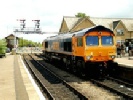Archive Section




By Gordon Mackley, Performance Manager, South Eastern Division, Network SouthEast, Notes by the author.
talk held on Tuesday 5th November 1991.
Present Timetable:
On the South Eastern side during the 'height' of the peak, both main line and suburban services operate on a 20 minute repeating cycle. This has existed for suburban trains since 1976, but in respect of Main Line trains, only since 1986.
Whilst there is a similar principle on the Chatham side, different calling patterns and the need to include a limited number of Blackfriars Mainline trains, and trains to the Central via Tulse Hill, causes a less rigid adherence to the principle, with a number of non standard intervals between trains.
The duration of the repeating 20 minute cycle working varies in respect of different lines of route but in all cases represents only part of the full evening peak period of 16.00hrs to 19.00hrs. The period from 16.00 to the start of the cycles has a "transitional" service when the basic half hourly off peak service is changed to the 20 minute cycle working. The reverse occurs after the cycle working towards 19.00. There are therefore a number of irregular intervals in services along the same route during these "transition" periods.
The workings on the South Eastern side inner area (WC book) and those on the Chatham inner area (WB book) have to mesh together between Chislehurst and St. Mary Cray Junctions (fast Cannon Street to Ramsgate services), and at Nunhead (Victoria/Blackfriars to Dartford lines trains). Services via Dartford beyond Strood also have to fit into Chatham Main Line services at Rochester Bridge Junction, whilst Maidstone East line trains and South Eastern Main Line services have to be fitted into a platform working at Ashford. For this reason it is impossible to adjust the basic cycle working on one side of the railway only.
Capacity and Performance:
During the full cycle working, much of the South Eastern operates to full capacity. This is especially true on the Eastern side where between the 16.55 and 18.15 trains, forty services start from the six platforms at Charing Cross. The 'corridor' between Orpington and Tonbridge is also a well known 'bottleneck' and between the same services 21 trains run along this section: nine running fast; four semi fast; four missing three stations; and four forming the all stations Sevenoaks terminating trains. This coupled with very tight crossing moves between Parks Bridge Junction and Grove Park makes for an extremely fragile timetable for South Eastern Main Line trains and thus a high quality timekeeping achievement extremely difficult.
On the Chatham side, between the 16.54 Cannon Street and 17.55 Victoria services 14 trains operate between Swanley and Rochester comprising: eight fast; two semi fast; and four stopping trains. Three trains are "slotted" in from Strood at Rochester Bridge Junction in the inner area; the problem is very different from the Eastern side, as there are two double track routes to Shortlands rather than one four track line. Both lines have all stations services and between the same two trains, services operate as follows: via Herne Hill: eleven fast, one semi-
From Shortlands onwards stopping trains require to operate on the Fast Lines to cross towards Petts Wood at Bickley Junction and towards Otford at Swanley. At the same time, in order to make maximum use of the Sole Street 'corridor', it is necessary for stopping Chatham services to also operate along the Fast Lines so that they can immediately follow from Swanley, the faster trains that have overtaken them on the Slow Lines. The combination of these factors makes the Outer Chatham timetable 'fragile' and reduces timekeeping quality.
The "66 Minute Hour" Concept:
The concept is that during the most intensive part of the peak, all services operate on the basis of a 22 minute interval cycle with one two minute 'slot' unoccupied.
In the Inner Chatham area (WB book), this creates an additional pathway every cycle via both Nunhead and Herne Hill. From Swanley to Rochester, the extra unallocated two minutes per cycle will reduce the fragility of the timetable and greatly improve timekeeping performance.
On the Eastern side, the extra two minute unoccupied 'slot' will ease the terminal working at both Cannon Street and Charing Cross, can be used to ease a number of tight workings in the inner area and will dramatically reduce the fragility of the Sevenoaks "corridor".
The net effect of this in timekeeping performance terms will be very substantial and should enable acceptable levels of quality to be achieved consistently on the Outer services.
Effect on Network Customers:
This has been minimised by fixing the middle cycle of the intensive working. Cycles before the middle will run two or four minutes earlier, whilst those after, two or four minutes later. By this system, the trains around the traditionally busiest time of 17.30 will be unaltered and no train would vary from the present time by more than four minutes. Because the periods before and after the full cycle working are not using the full capacity, all trains via all routes can still be operated. In essence the proposal achieves a long term objective in 'spreading the peak' without any greater variation in the actual timing of services than often occurs in a normal retiming exercise.
Producing the Timetable:
Because of the many flat junctions, involving crossing moves of up contra peak services, it has been necessary to rewrite the entire timetable (WA,WB,WC books). It would not have been possible simply to insert an empty slot on each route. The complete rewrite has, however, given the opportunity to make the best use of the easement in working at the various locations by adjusting where the 'empty slot' falls, dependent upon the most critical movement at that location. For example the 'double-
For reasons already explained, the timetable produced to incorporate Channel Tunnel services into the evening peak, would have involved a complete rewrite of all three timetable books, in any event. 1992 thus gives a very suitable opportunity for the introduction of the proposed revised timetable.
Incorporating Channel Tunnel Eurostar Trains in the Existing Timetable:
It is clear from the above that in the height of the current evening peak working, no extra services could operate via Herne Hill. The four minute 'slots' required for Channel Tunnel trains would require Network services to be diverted via Nunhead for each Channel Tunnel train. These would incur three minutes extra running time to Shortlands. The pathing of these trains beyond Shortlands to meet the other pathing requirements at Swanley etc. would prove extremely difficult if not impossible.
Such a Channel Tunnel service, assuming it could be 'squashed' in would imply a considerably worsened service on the Maidstone East line as well as for the intermediate stations via both Penge and Catford. It would also affect the flighting of trains between Swanley and Rochester and reduce capacity on this section. What would be certain is that extra trains 'squashed' into the working would make the timetable even more fragile on the Chatham side and the performance very much worse. The Eastern side timetable would contain all the currently existing fragile elements. It would be inconceivable that Channel Tunnel trains superimposed on to this working could run at the consistently high levels of timekeeping performance required of them.
Requirements of the 1992/3 Timetable:
The requirement is that the timetable should provide no fewer trains in the evening peak along the existing routes than current services without significant increase in journey times, or deterioration in timekeeping performance, whilst at the same time providing pathways for up to three Channel Tunnel trains per hour.
Adding the Channel Tunnel Trains into the '66 Minute' Hour:
Channel tunnel trains have been added into the revised timetable on the basis of the international requirements. This has required diversion of some Network services from Victoria via Catford, some via the Atlantic Lines and some via Stewarts Lane Junction, although less have been diverted via Catford than would have been necessary on a normal 20 minute cycle pattern. The pathing on the critical Herne Hill to Shortlands 'corridor' in the inner area is no tighter than that currently existing in the 1990 20 minute cycle, whilst the working has been eased on the Swanley/Rochester corridor. The additional two minute slot available at Sevenoaks has enabled one Channel Tunnel train in the evening peak (the 17.57 Waterloo to Brussels) to be routed via Bat and Ball and Tonbridge rather than Maidstone East. No such option would have been possible within the 1990 20 minute cycle.
Because the agreed maximum number of longer journey time paths (via Maidstone East) are used for Channel Tunnel trains in the height of the evening peak, it is necessary for the 18.27/18.53/18.57 departures from Waterloo International to be routed via Orpington and Tonbridge. Towards the end of the peak, it has therefore been necessary to 'fit' Network trains via Tonbridge around the pathways of these International services. This would have been equally necessary but even more difficult with a repeating 20 minutes cycle base. The workings during this period thus created are again no tighter than currently exist with Network trains. These services will now follow sequences where there have been gaps to break up minor late running however, as opposed to the present pattern, where cycles repeat with no margin between.
Conclusion:
This concept not only represents a real opportunity to dramatically improve South Eastern evening peak performance within the constraints of the present/foreseeable future infrastructure but also the only practical option which will meet the objectives of the two businesses and comply with the undertakings given in respect of timetables incorporating Channel Tunnel trains.
|
If you have enjoyed this article, you may also be interested in the following articles by the same author: |
|
|
A description of Network SouthEast’s, South East Division's Control, London |
|
|
|
An account of the Performance - |